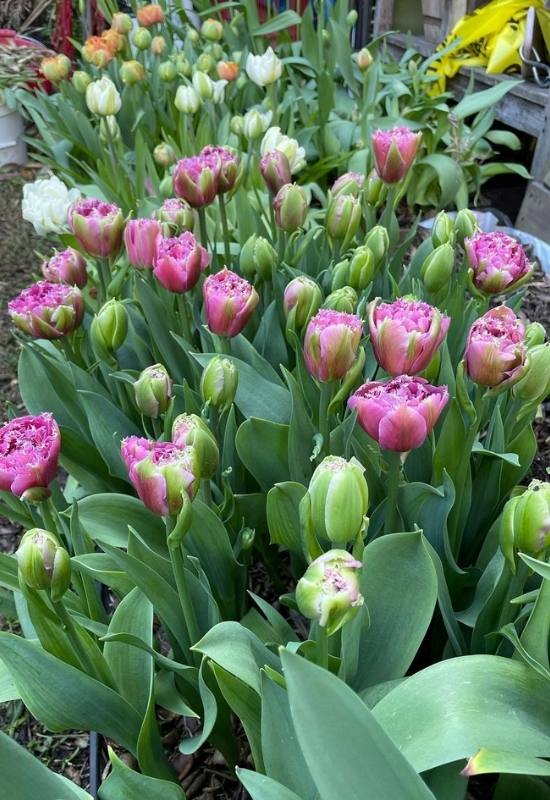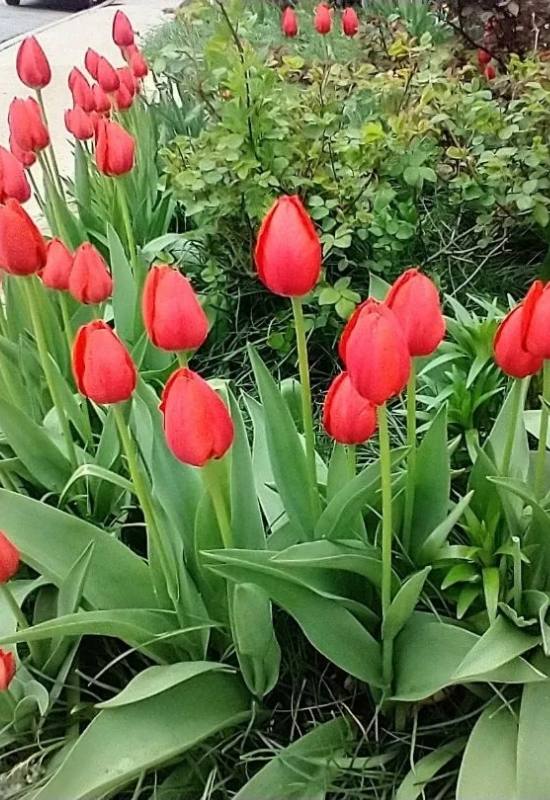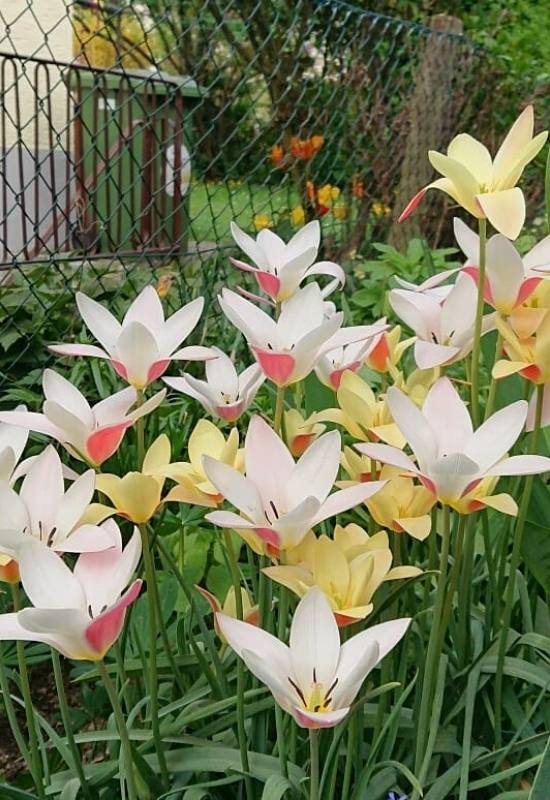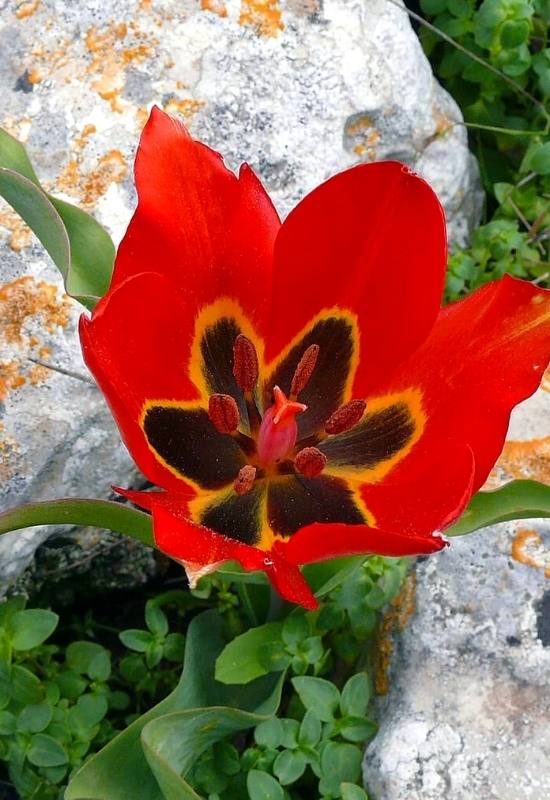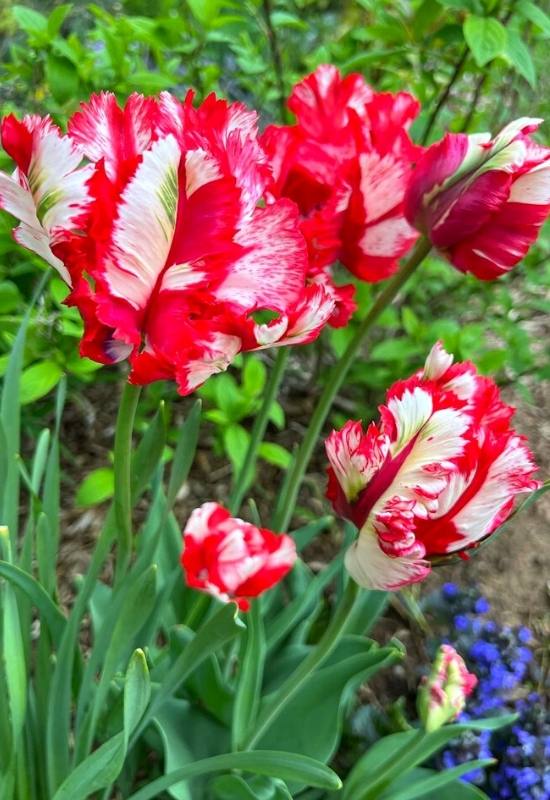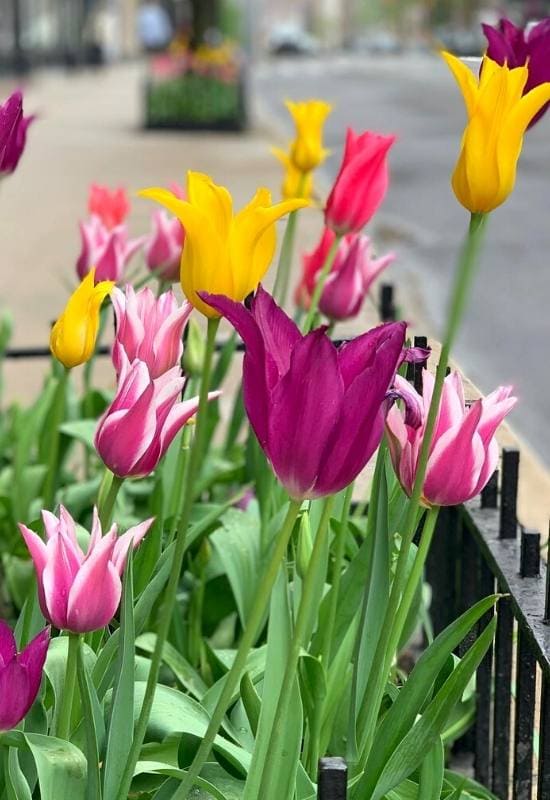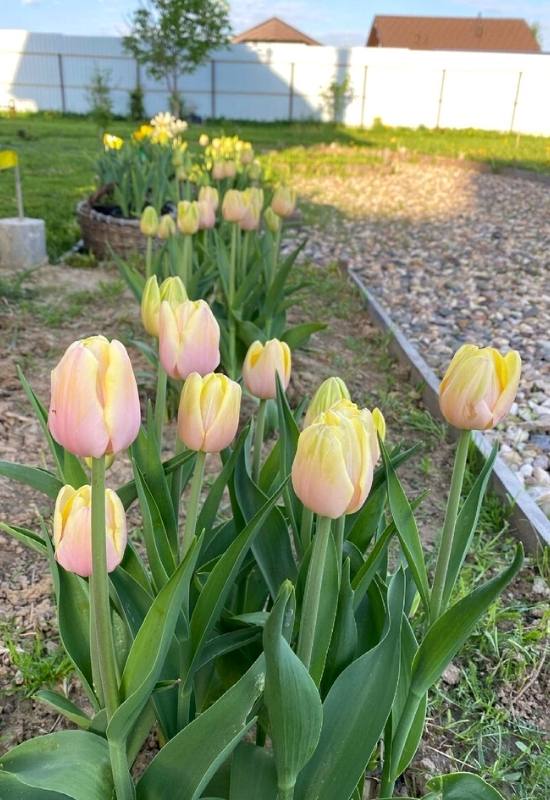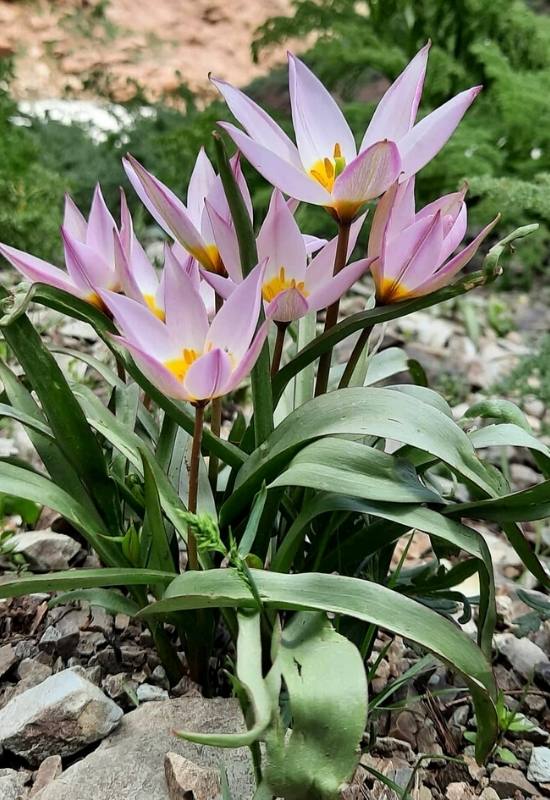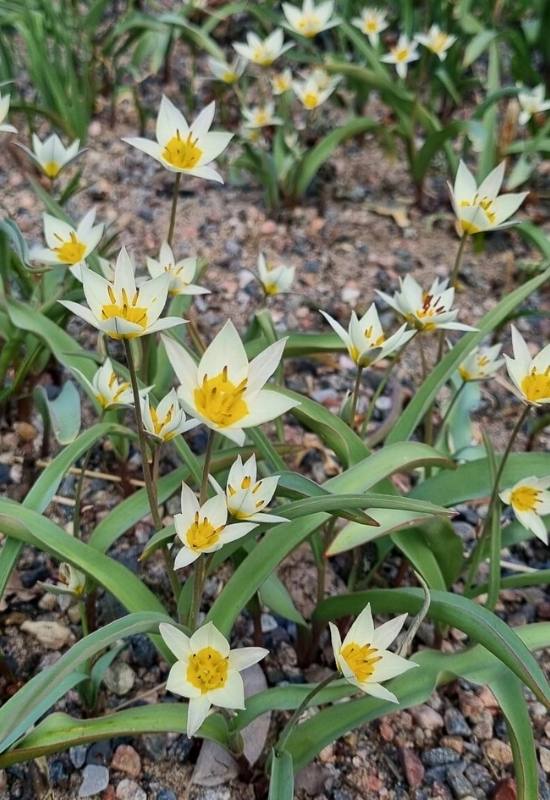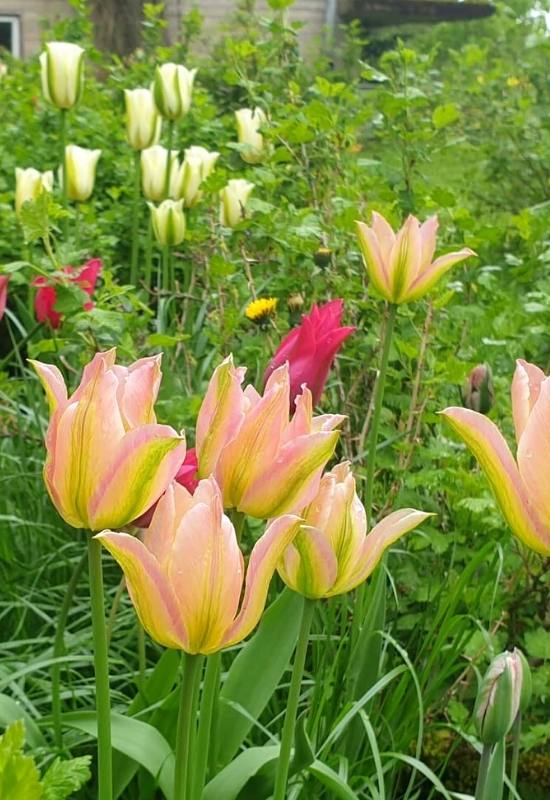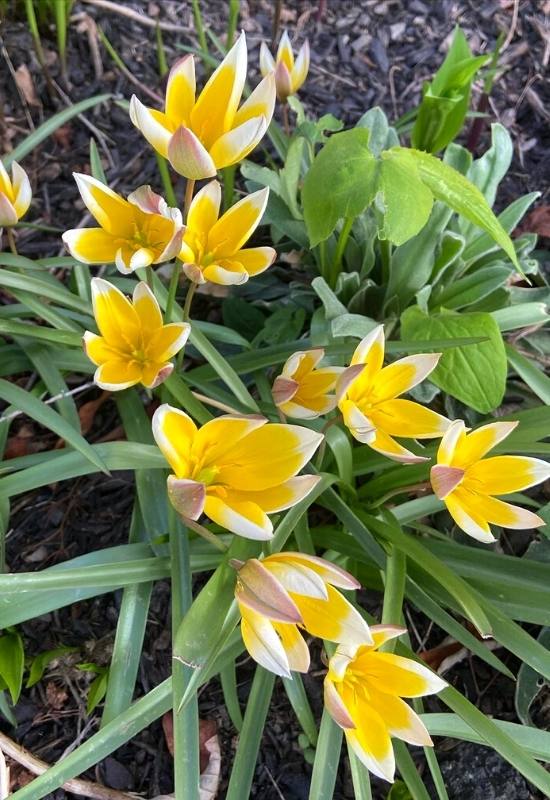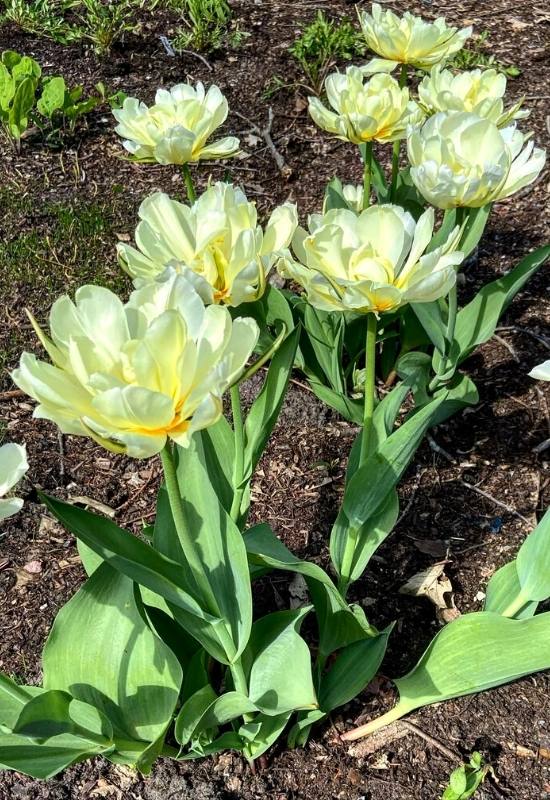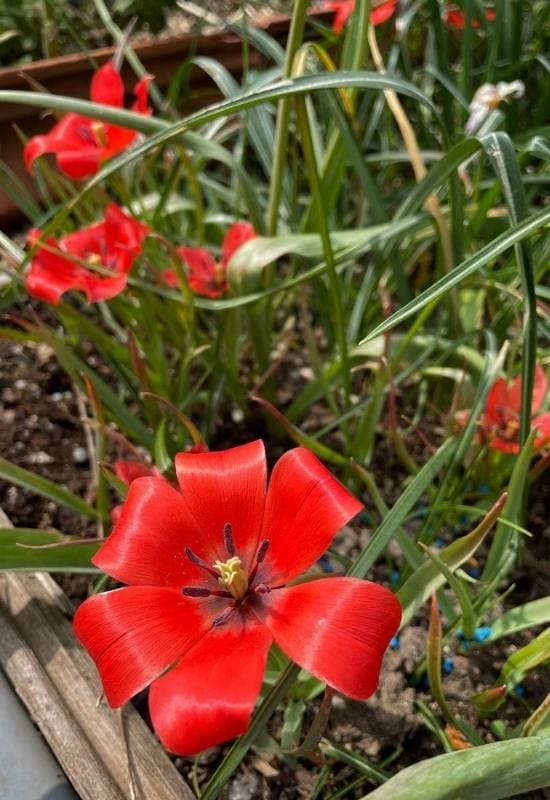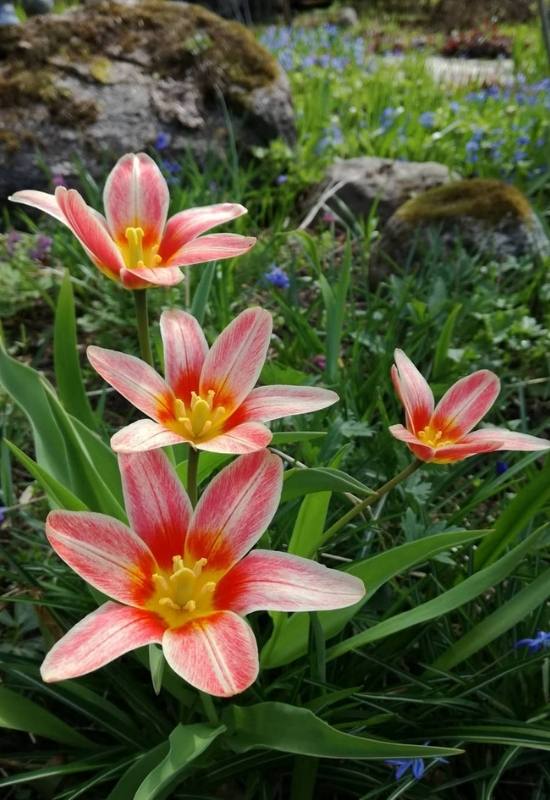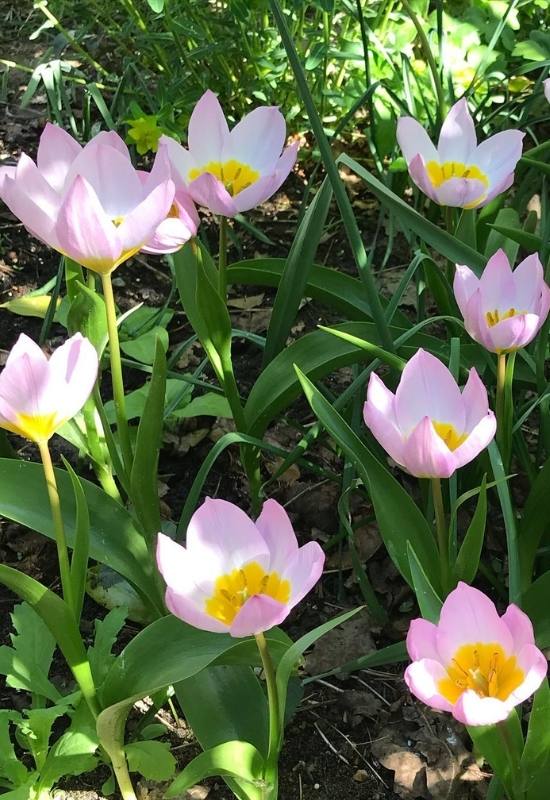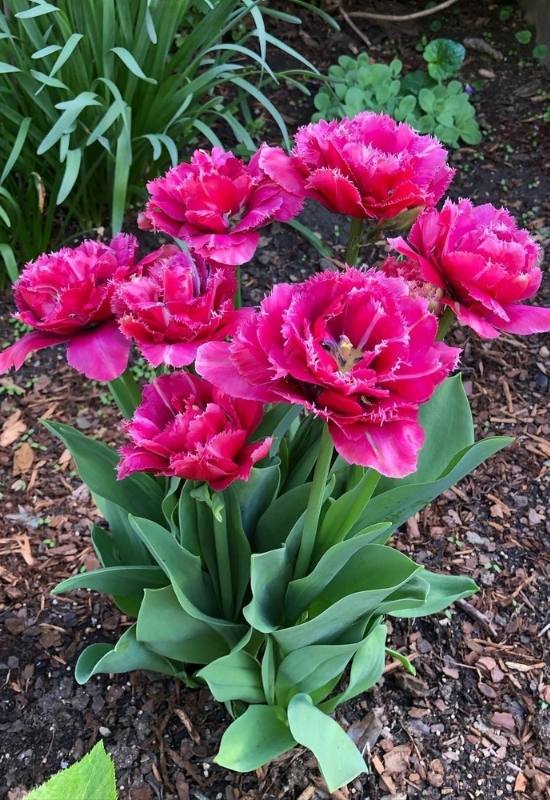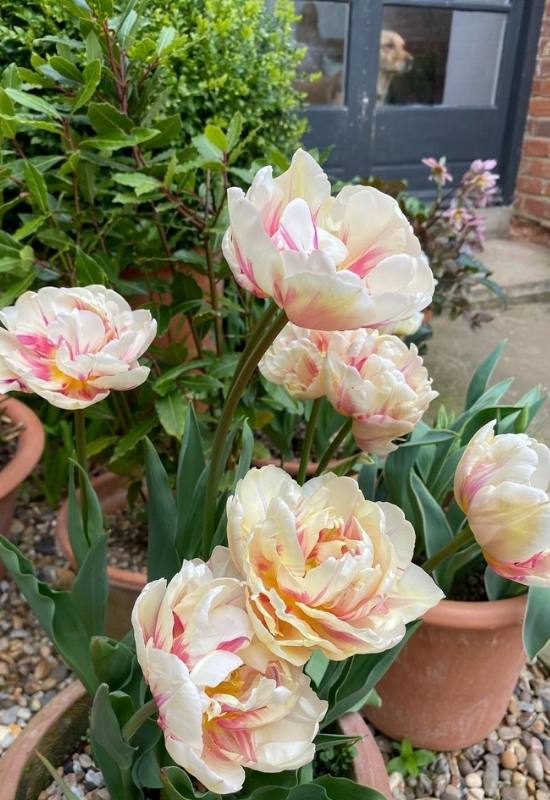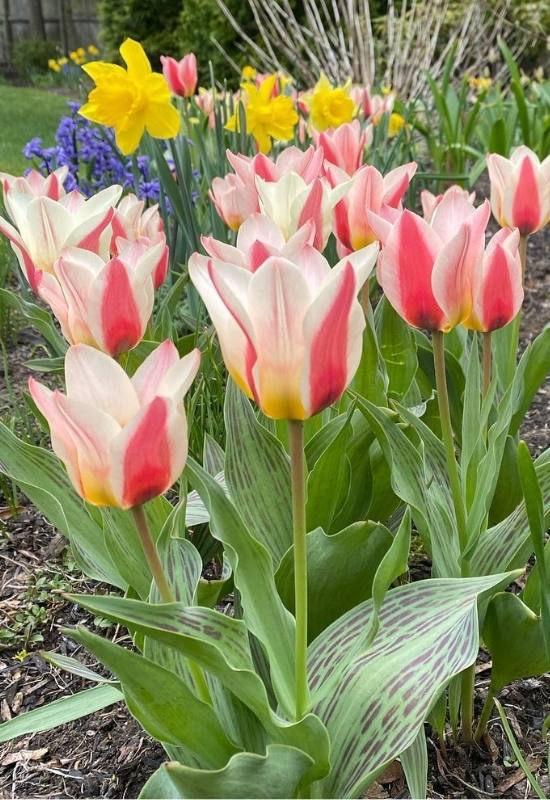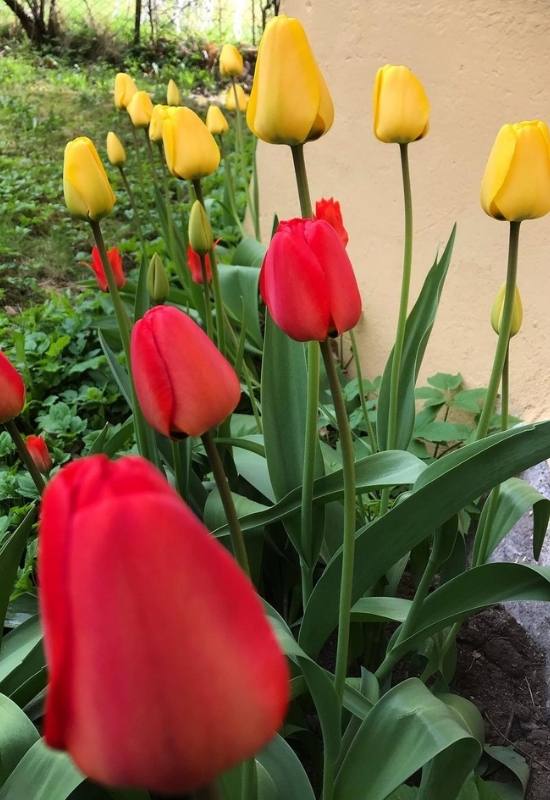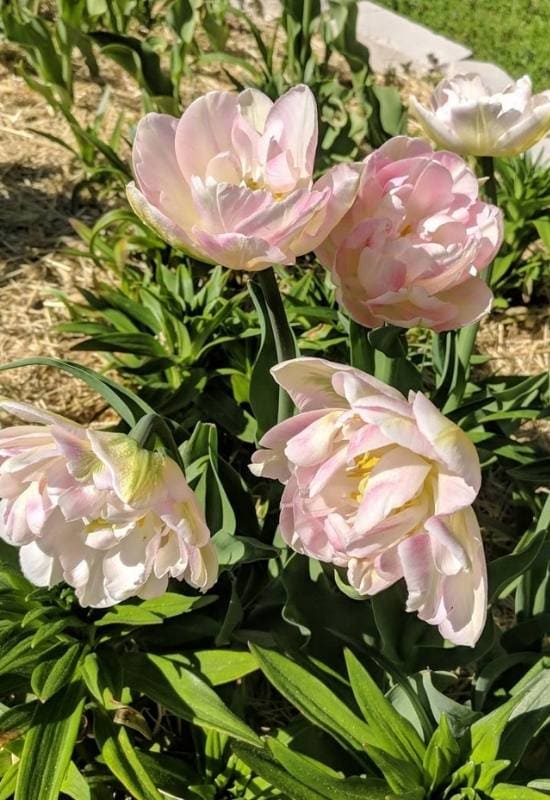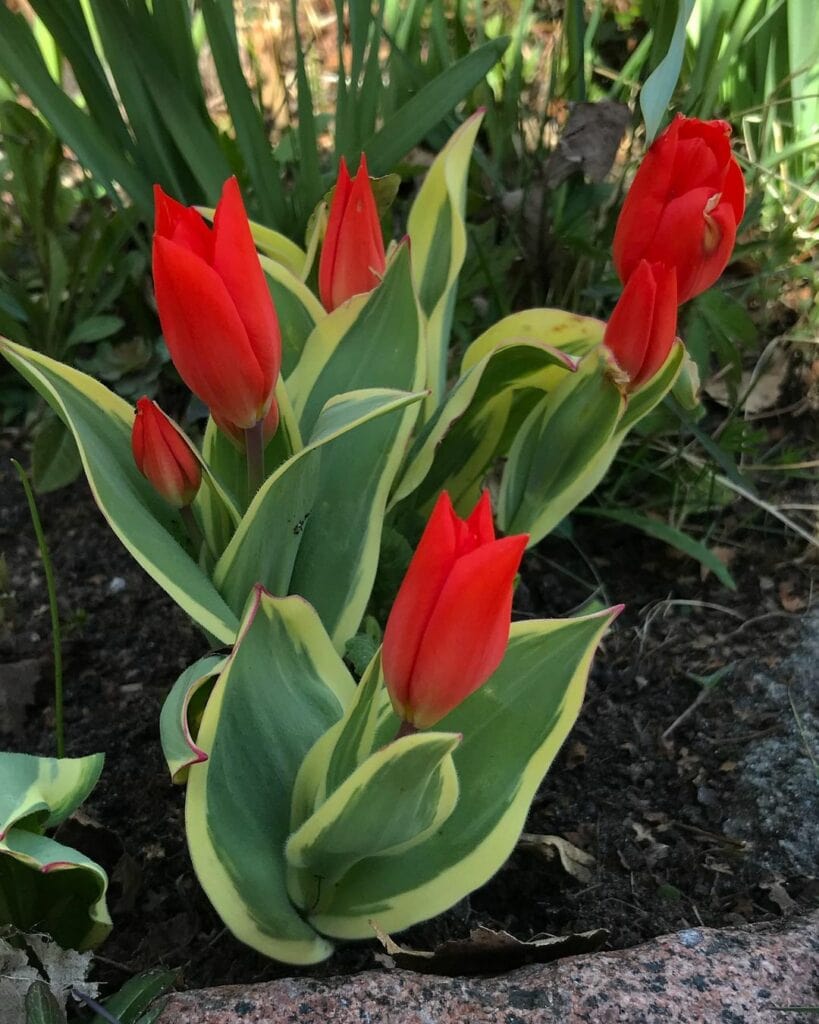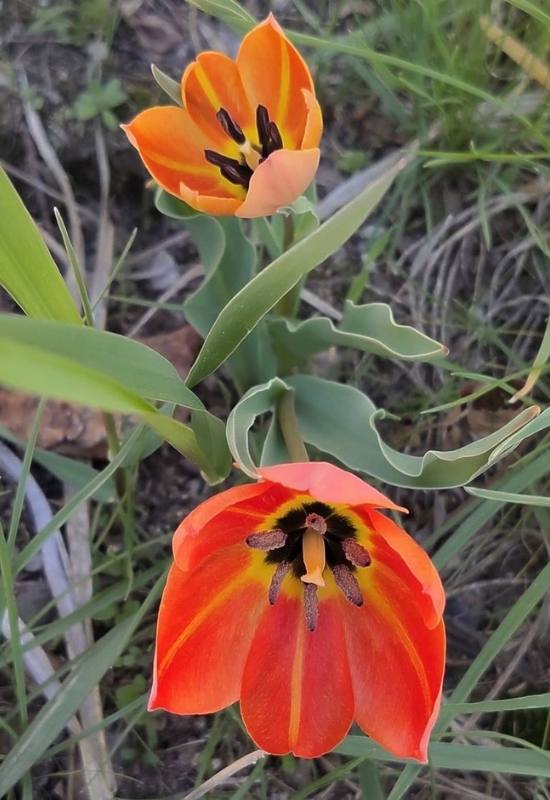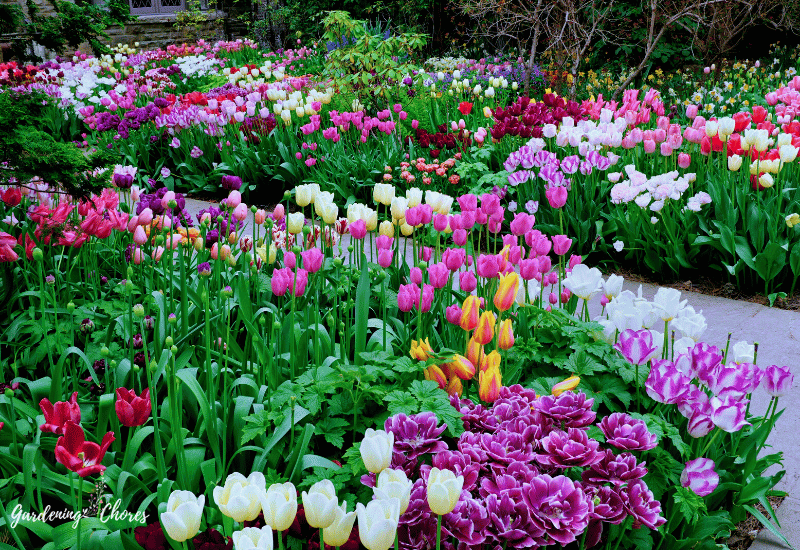
Flagship flower of spring, timeless, tulips are among the great classics of the garden to add a splash of freshness and vitality to gardens after the long, cold winter months.
Tulips, with their 20 to 70 cm robust stems, reach towards the sky. They come in a multitude of colors – white, yellow, red, orange, purple, pink, sometimes very dark, almost black. The flowers take different shapes, they can be either single or double, plain or multicolored, with cupped, star shaped, closed, egg shaped petals, providing wonderful patterns.
There are even some with variegated leaves! In fact, we count the types of tulips in the thousands. Belong to the Liliaceae family, the lily family, there are more than 3,00 varieties of tulips, and 75 species of Tulipa, with more than 3,000 cultivars and hybrids. All different, they are grouped into about 40 categories, and 15 are the most common in gardening, including botanical, garden viridiflora and triumph tulips.
In fact, the ‘king of bulbs” is not just a great protagonist of the history of gardens, and even of economics (!!!), it is one of the most varied perennials you can ever find, and a real asset to flower beds all over the world.
To help you find your way around, we have added some less common types of tulips, including a few collector’s items to give you a wide picture of the amazing variety of colors, shapes, sizes bloom time of this queen of flower beds, the noble and elegant tulip!
A short History of Tulips
Tulips are spring-blooming bulbous perennials of the genus Tulipa and Liliaceae family, a native of Central Asia, the Middle East, Europe, and Mediterranean regions, including North African countries like Morocco, Algeria, and Tunisia.
There are about 70 extant species of tulips and 4 subgenera. However, this flower has been bred for centuries, so we can only estimate a whopping 3,000 registered tulips varieties, including hybrids and cultivars!
Tulip Flowers
Tulip flowers are iconic and famous all over the world, with a wide range of colors, and they are a symbol of spring as well as of the country that has made growing them a national pride: the Netherlands.
They open during the day, and they close at night, but they do not usually last long; depending on how fresh is the temperature, they can last one or two weeks, but the buds are beautiful as well.
Tulip Fun Facts
There are some fascinating facts about tulips… They were first grown in the Islamic World, not the Netherlands, and as far back as the 10th Century CE!
However, the strange twist in their history came when they first came to Europe, where the bulbs became actual currency. In fact, they determined the very economies of whole countries and even the collapse of the Dutch stock market in the Seventeenth Century… the very first “big recession” to come from speculation.
And speculation was big time because their prices reached exorbitant prices, including whole properties, coaches of gold, and even castles!
The single bulb with the highest price ever was a ‘Semper Augustus’ tulip in march 1937, which sold for 5,000 florins, an absolute fortune at the time!
Thankfully, now they are cheap!
Basic Tulip Care Tips
Even if now we can buy half a dozen tulip bulbs for the price of a coffee, a few basic care tips will save you lots of time and headaches, so here they are…
When and How to Plant Tulips
The usual time for planting tulips is mid-October, but you can have some leeway here; planting it at the beginning of the month or the first weeks of November is fine.
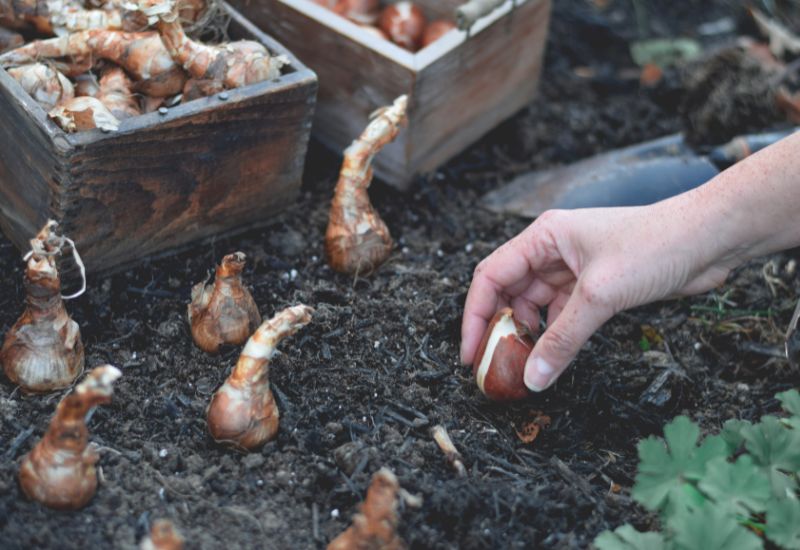
Watering Tulips
In most temperate countries, you will need little watering because spring is a wet season, and rainfall will do most of the job for you.
However, when you see the leaves come out of the soil…
How to Fertilize Tulips
If the soil is rich in humus and organic matter, you don’t need to fertilize tulips. They will have all the nutrients they need for their short vegetative and reproductive phase. This is true in pots as well.
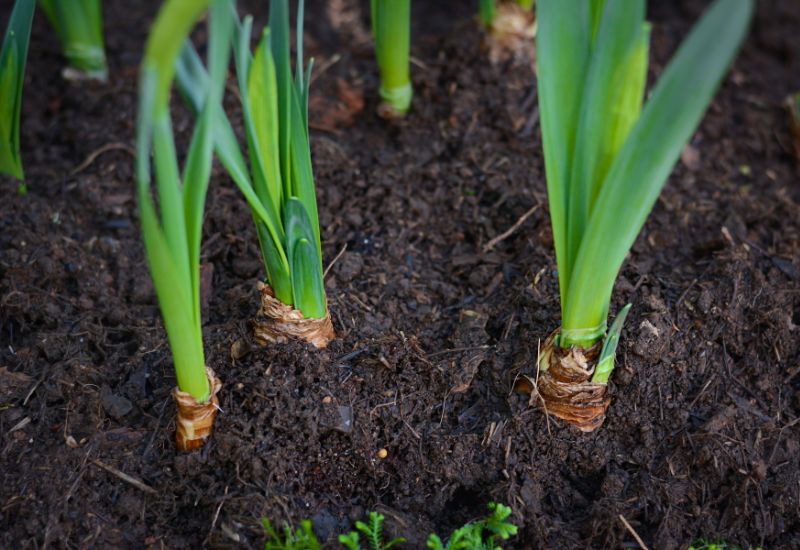
But we don’t all have very fertile land. If you wish to use some fertilizer, then do the following:
Why and How to Deadhead Tulips
As soon as the bloom is spent, deadhead the tulip cutting the stem to just above the first leaf. If you don’t, it will produce fruits (capsules), and the bulb will shrink. Instead, if you do, the plant will send energy into the bulb, and you will get a plump and healthy one to plant for next year, and, finally…
Resting Tulip Bulbs
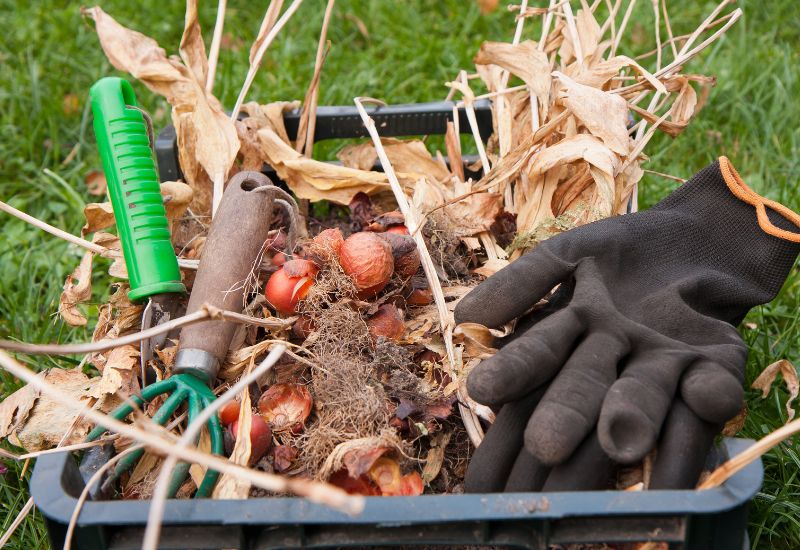
In most countries in the world, if you leave tulip bulbs in the soil, they will shrink, rot, become ill, empty, and even die completely, so…
And when October comes, the cycle starts all over again by planting the bulbs in the ground.
Propagating Tulips
The best way to propagate tulips is by bulb propagation. If your tulip is healthy enough and you deadhead it in time, when you take it out of the ground, you may find small bulbs…
That’s simple, but if you want a simple and visual summary of it all.
Top 22 Types of Tulips To Brighten Up The Garden From March To May
Here is the moment you have been waiting for; you are about to meet and see 22 types of tulips that will blow your mind off! And we can start straight away!
1: Garden Tulip (Tulipa gesneriana)
The most common and iconic type of this famous flower is simply called the “garden tulip.” The large and colorful flowers have the classic cup shape with long petals that close at night and can reach about 4 inches in length (10 cm).
They appear singularly in spring on upright stems, while at the base, the broad and lanceolate leaves, fleshy and with a blue-green color, are between 12 and 26 inches long (30 to 65 cm).
You will only get one flower per bulb per year, which will not last long, but the wait and effort are worthwhile.
The choice of varieties you get with garden tulip is huge, including most tulip cultivars in the world; the bloom color is the main difference, and the palette includes a vast range from white to dark purple (the famous “black tulip“) and other vibrant colors like green.
This is a queen of spring flower beds, where it really excels in both formal and informal styles. It is also a favorite cut flower all over the world.
2: Lady Tulips (Tulipa clusiana)
As the name suggests, lady tulips are exquisite flowers with long and pointed petals. This species from Afghanistan, Iran, Iraq, and Pakistan have found perfect conditions in Southern Europe, where it has naturalized.
The flower buds are very long and thin. When they bloom, they form stars, opening almost completely for the day. The petals themselves have a waxy, glossy surface.
There are famous varieties of lady tulips, such as ‘Lady Jane,’ the award-winning ‘Cynthia,’ and ‘Peppermintstick.’ These tulips have bright white petals with purple to red undersides.
The leaves are fleshy but long and narrow and mid-green in color.
Lady tulips are particularly suitable for rocky soils. Still, their original and striking beauty makes them ideal for flower beds or rock gardens.
3: Red Tulips of Bologne (Tulipa agenensis)
The Bologne tulip is a showy red flower that stands out among other varieties. Though it gets its name from the Middle East, this plant has naturalized all over the Mediterranean.
If you want to add excitement to your garden, look no further than this type of Tulipa. These flowers are sure to grab attention with large, flaming red petals 4 inches across (10 cm), a full center, and softly pointed tips.
In the center of this flower, you will notice a beautiful star-shaped pattern with black patches and dark yellow lines. The leaves are green, long, and narrow; they arch from the base of the plant.
This particular variety has been grown for centuries because it adapts so well to hillsides, natural-looking gardens, and formal beds if that’s what you have. Another perk is that the blooms last longer than other varieties!
4: Parrot Tulips (Tulipa x gesneriana Parrot Group)
Parrot tulips are a series of cultivars originating from garden tulips. They are distinctive because the petals have frilled and ruffled edges, giving you a fine texture and the impression that they are like the plumes of birds.
The parrot tulip is more flamboyant than the common Tulipa, with large, spherical flower heads that can reach 4 inches in diameter.
The two most famous varieties of parrot tulip are “Apricot Parrot” and the dark purple ‘Black Parrot,’ both of which have won the Award of Garden Merit from the Royal Horticultural Society.
However, my personal favorite is the gorgeous ‘Flaming Parrot’ with canary green petals and a luminous cross pattern of scarlet red.
Parrot tulips make for a perfect, showy addition to any flower bed or garden, as they come in such lovely vibrant colors. They also make great cut flowers for bouquets and arrangements.
5: Lily Flowered Tulips (Tulipa x gesneriana Lily Flowered Group)
Also called “fluted,” lily flowered tulips belong to an exquisite hybrid group. The blooms are distinctive because they have long and pointed petals that open, only partly from the tips, arching and giving you the shape of a decorative calyx, of a vase…
There are cultivars with narrow and long blooms, like the luxurious crimson red flowers or the golden yellow ‘Seattle.’ Others have larger cups, like the purple ‘Lasting Love’ or the dark magenta with white edges “Ballade.”
The most eccentric is the deep magenta “Doll’s Minuet,” which has extended arching petals that make it look like a bonfire.
Lily flowered tulips will add elegance and exciting shapes to flower beds, and in a lovely bouquet, they work wonderfully well as cut flowers.
6: Triumph Tulips (Tulipa x gesneriana Triumph Group)
Triumph tulips are a group that is distinctive for their extensive, broad, and rounded blooms. While the buds look like clouded lotus flowers, when they open, they will give you cups that reach about 4 inches across as well as in length (10 cm) and the rounded tips of the petals complete this soft, smooth and harmonic effect.
They come literally in all colors, from white to dark purple, with multicolored varieties as well. For a luxurious-looking cultivar, “Arabian Mystery” is by far one of the most impressive, with deep, dark purple petals and white edges!
Triumph tulips have particularly showy blooms, so they work well in both formal and informal flower beds and make perfect cut flowers.
7: Crocus Tulips (Tulipa humilis)
Coming with its delicate blooms from the Middle East and the Caucasus, the crocus tulip is one of my favorites and a low species.
The large and star-shaped blooms can reach 4 inches across (10 cm) with their pointed petals and open blossom.
However, what makes it really elegant is the colors it has in its palette, from pastel violet-blue to rose pink and then magenta; this makes this flower by far one of the most unusual but also sophisticated tulip types. The long and narrow green foliage arches at the base give the blossoms their perfect backdrop.
Crocus tulip is ideal for rock gardens, especially in its low-growing varieties, but if you have some space left in your flower beds, go ahead and plant the bulbs.
8: Turkistan Tulips (Tulipa turkestanica)
Turkistan tulips offer you a small but very cheerful type of Tulipa from Central Asia. They became popular thanks to Dutch breeders and sellers in the last part of the Twentieth Century, but they have been known since 1873.
These have short stems and small flowers, about 2 inches across or a little more (5.0 cm), but the perfect star shape of the blooms, white with bright yellow centers, makes them very eye-catching, energetic, and decorative.
These don’t come individually, like in other varieties, but in inflorescences, or racemes, to be exact. The bright green leaves are long, pointed, and narrow.
While Turkistan tulips will do their duty in small flower beds and pots, their real ideal setting is a lovely rock garden, where they can bring all their joy.
9: Viridiflora Tulips (Tulipa viridiflora)
Viridiflora tulips, while lesser-known, are a new hybrid group with many characteristics. For example, their blooms are large and broad with wavy, curving petals.
This gives them an overall dynamic look, further enhanced by the vibrant and ever-changing coloring of the blooms.
The Viridiflora tulip is especially adored for its wide variety of colors in the flower heads, which can include white, green, pink, red, yellow, and purple. These bright flowers are perfect for adding some contrast and color to your garden beds or as cut flowers.
10: Botanical Tulips (Tulipa tarda)
Botanical tulip is a small protagonist of Tulipa types and quite distinctive. Small and with open, almost flat, and star-shaped blooms, the petals are white and pointed but with large heart-shaped golden areas towards the middle.
Unlike other varieties, botanical tulips can be naturalized, and their blooms are very generous indeed. In fact, it’s one of the oldest categories of this flower ever to make it into gardens; it has been grown and cultivated since 1590!
Despite its small size, it is a winner of the prestigious Award of Garden Merit by the Royal Horticultural Society.
Botanical tulips are the best choice for a naturalized area or even the border of the bed; while their color range is small, they are very bright and energetic indeed! They are also ideal for containers, and they are also cold-hardy.
11: Emperor Tulip (Tulipa fosteriana)
Unlike botanicals, emperor tulips have a wide range of colors and shapes, and they are a varied group that is more difficult to identify.
Coming from the Pamir Mountains of Afghanistan, Kyrgyzstan, Tajikistan, and Uzbekistan, they can be yellow, white, orange, red, or pink, but they also offer some green dashes at the base. With a thick stem, the large blooms can be cupped and with short or pointed, and even with petals that flex outside.
The anthers inside these dark violet tulips are very long. The ovate and glaucous leaves have a typical upright posture. Still, the most famous cultivar is “The Orange Emperor,” which has won the Award of Garden Merit from the Royal Horticultural Society.
Ideal for colorful beds and containers, emperor tulips are a collector’s item. But they aren’t impossible to find if you just want an unusual type of Tulipa for your front garden.
12: Flax Leaved Tulips (Tulipa linifolia)
Flax-leaved tulips have unique petals that set them apart from other types of Tulipa. When they mature, the broad and pointed petals open fully and turn downward with a floppy and irregular bend. When young, however, they retain the shape of an open cup or saucer.
While other species would view this behavior as a cause for alarm, our bright red flowers with black centers from Afghanistan, Tajikistan, and Uzbekistan are perfectly normal. The leaves are also strange-looking; they’re sword-shaped and wavy with red margins!
Flax-leaved tulips make for a great collector’s item, but if you want to add some drama to your flower beds or containers, they’re worth growing!
13: Water Lily Tulips (Tulipa kaufmanniana)
The water lily tulip originated in central Asia. As its name suggests, it looks strikingly similar to the pond flower. This is especially true for natural varieties; they have longer and more open petals that come in colors like white with golden centers, yellow with red centers, and other combinations.
As a result, they often look very eye-catching. The petals of the tulip gradually bend outwards until the bloom is in a star shape, approximately 4 inches wide.
The broad and green foliage creates a beautiful contrast with the blooms and lasts weeks longer than the blossoms.
Water lily tulips are excellent for rock gardens but can also be placed in beds or low borders. This type of tulip has some offering unique flower shapes compared to other varieties of tulips.
14: Candia Tulips (Tulipa saxatilis)
The Candia Tulip is a gorgeous but lesser-known type of tulip. If you’re a collector, this is one flower that you can’t miss!
With extensive and open blooms, this native of Turkey and Greece has broad petals that are gently pointed and vibrant lilac pink in color with bright golden yellow centers.
The stem of these flowers are upright, and the leaves at the base are very distinctive. The mid-green, lanceolate leaves are fleshy, waxy, and glossy. Cultivars like “Lilac Wonder” have deep magenta and elongated petals or subspecies bakeri with the same color but short and rounded petals.
However, if you want to really impress your visitors with your flower beds or rock garden, go for the natural mother species from the Aegean Islands.
15: Fringed Tulips (Tulipa Fringed Group)
Fringed tulips are hybrids with petal edges, thin cuts, and soft teeth, which sets them apart from other tulips, including garden tulips.
With a wide range of cultivars and colors, from white to dark purple, including all warm shades, they have the classical shape of these flowers with green lanceolate leaves and upright stems.
But their Touch is what makes them unusual – fringed tulips are favorite cut flowers thanks to the lace-like edges of their petals, but they are also protagonists in both formal and informal flower beds.
16: Double Early Tulips (Tulipa Double Early Group)
The Double Early Group of tulips were bred from garden tulips to have large, showy, and colorful double flowers that blossom in early or mid-spring. With this characteristic, they vaguely resemble the shape of a gardenia or rose more than the mother species does, losing the iconic silhouette along the way.
Some tulips are even fragrant, and when you grow a diversity of colors, you get a more interesting color palette with greater dimension. When still closed, they are globular, and when open, they can look untamed–a bit wild.
Some gardeners don’t prefer double early tulips because they believe that it lacks purity. Others disagree and grow them in large groups as a means to add a significant pop of color.
17: Greigii Tulips (Tulipa greigii)
The greigii tulips, yet another group of Tulipa hailing from central Asia, are certainly original. As is typical, many cultivars are now available from the natural red-petaled species. However, all these varieties share the common trait of blooming in a bowl shape.
However, we can also have yellow and orange blooms in more modern versions of the plant. Furthermore, they have very distinctive foliage; the fleshy green leaves often have purple strips or spots on them! The “Red Riding Hood” is a cultivar that particularly excels at this display, with blue, purple, and green patterns. In fact, this tulip variant has won the Award of Garden Merit from the Royal Horticultural Society.
Ever since 1872, Greigii tulips have been a popular type of garden flower. They open up entirely in the sun but then close back up at night. Whether you’re looking for something formal or informal, these tulips are a great option and will work well in any type of design.
18: Darwin Hybrid Tulips (Tulipa Darwin Hybrid Group)
The Darwin hybrid tulips, developed by Dutch breeder D.W. Lefeber, are ideal for cutting and arrangements because they grow tall – frequently surpassing 3 feet (90 cm).
They have cup-shaped blooms that are approximately 3 inches wide (7.5 cm), with slight variations depending on the variety of tulips, and can be up to 4 inches long (10 cm).
The Tulipa genus comprises more than 3,000 cultivars, giving you various colors. Additionally, many have won the Award of Garden Merit by the Royal Horticultural Society, such as the delicate pale yellow “Ivory Flordale,” rosy salmon “Big Chef” and apricot with orange edges “Daydream.”
One of the most popular Tulipa groups is darwin hybrids which are highly sought after for their incredible color range and long stems that make them perfect for any border or bouquet.
19: Double Late Tulips (Tulipa Double Late Group)
Double late tulips are similar to double early ones but blossom later in the springtime, from May to early June. Large and full of petals, they have rounded buds that open up into rose-like blooms.
There is a wide range of colors, from snow white “Mount Tacoma” to dark purple “Uncle Tom.” The group includes winners of the Award of Garden Merit by the Royal Horticultural Society, like striking “Carnaval De Nice” with raspberry splashes on a white background or delicate pastel rose with purplish blush “Angelique.”
They are also generally taller than early varieties, which makes them better-cut flowers. For a rich display later in the season, double late tulips are a great asset to flower beds and borders, as well as in a vase on your dinner table or working desk.
20: Praestans Tulips (Tulipa praestans)
One of the most defining features of praestans tulips are their sharp, pointy petals. When in full bloom, they form lovely cups with sharp tips that resemble crowns. Blooms are typically about 2 to 2.5 inches wide (5.0 to 6.5 cm).
The praestans tulips, native to Tajikistan, can produce one or more flowers per bulb. An unusual trait of these gray-green leaved plants is that they have hairs at the fringes!
The colors range from yellow to red and come in many hues and shades due thanks to cultivars bred since their introduction to gardening in the early 20th Century.
Praestans tulips are fairly short and look great in wild landscapes, like rock gardens and informal beds; They also tolerate more acidic soils than other varieties.
21: Schrenck’s Tulips (Tulipa suaveolens)
The scientific name for Schrenck’s tulip is “nice smelling” because it gives off a pleasant fragrance. This type of tulip is quite rare and considered to be elegant by many people.
It originates from Eurasian steppes, which are located in Ukraine, Crimea, and European Russia, as well as some regions near the Sea of Azov. The tulip is a medium-small type of flower with long, slender stems.
Its elegant thin buds open wide to the sun, and its leaves are usually glaucous (light greenish-blue) and undulate (wavy). The blooms can be red, pink, orange, mauve, yellow, or white. There are also multicolored varieties with margins of the last two colors.
It creates beautiful displays with its bright flower heads in natural settings such as wild meadows. Schrenck’s tulips were initially bred in the Middle East during the 16th century but have since made their way to European gardens.
They make for a beautiful addition to any flower bed or if you’re looking to recreate its natural habitat.
22: Korolkowii Tulips (Tulipa korolkowii)
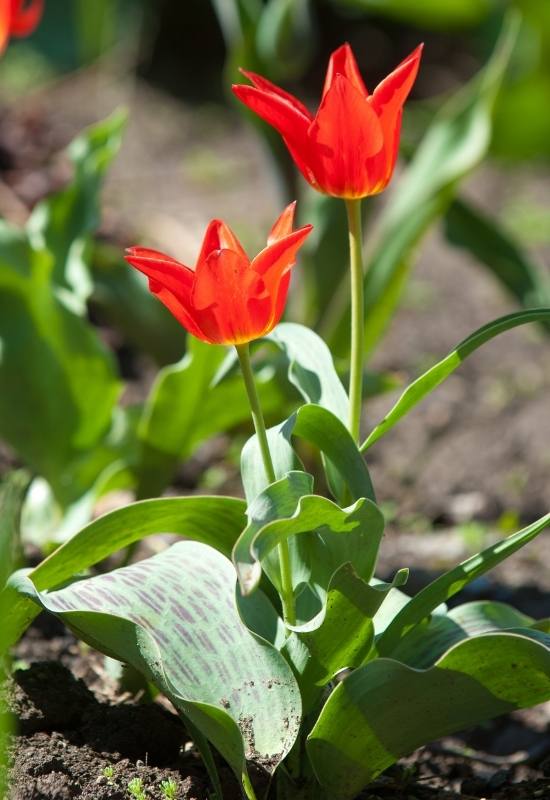
Central Asia is home to the craziest type of Tulipa, korolkowii tulips. They are so unique that you might not even mistake them for real tulips at first glance!
These tulips have broad, wing-shaped petals that open wide and flat, sometimes resembling a large butterfly or star. They can measure up to 4 inches across (10 cm).
Korolkowii tulips are most often red, but they can also be yellow, orange, or white. Their centers can be black, golden, or rarely white!
These tulips have broad, fleshy leaves that are bluish-green in color. They arch beautifully at the base of the plant, making them perfect for anyone who loves tulips but also enjoys the untamed look of wilderness.
You can keep them in beds, rock gardens, or even containers.
So Many Different Types Of Tulips
There are even more types, groups, and categories of tulips. More than 40, but some are very rare indeed, and we have already seen a few less common ones…
But one thing for sure: if you came to this article with the idea that tulips all look the same but change in color, I bet you have changed your mind…

Written By
Adriano Bulla
After many years as an academic in London, Adriano Bulla became a writer, publishing books like A History of Gardening, Organic Gardening and Elements of Garden Design; he then decided to become a gardener, following his childhood dream, and has been following his dream writing and gardening professionally in Southern Europe, where he has specialized in new and innovative organic gardening fields and techniques, like permaculture, regenerative agriculture, food forests and hydroponics.

